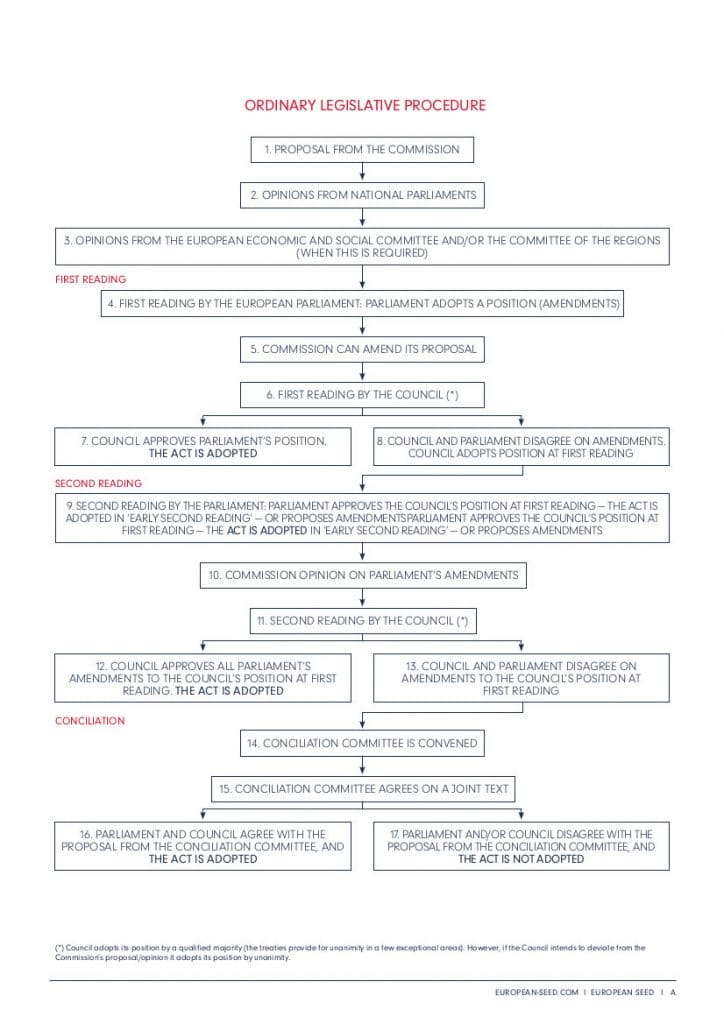EU decision making
Various European institutions are involved in decision-making at EU level. The most important bodies are:
- The European Parliament, representing the EU’s citizens and is directly elected by them
- The European Council, consisting of the Heads of State or Government of the EU Member States
- The Council, representing the governments of the EU Member States
- The European Commission, which represents the interests of the EU as a whole
The European Council defines the general political direction and priorities of the EU, but it does not exercise legislative functions. Generally, it is the European Commission that proposes new laws and it is the European Parliament and Council that adopt them. The Member States and the Commission then implement them.
Types of legislation
There are several types of legislation, and these are applied in different ways.
- A regulation is a law that is applicable and binding in all Member States directly. It does not need to be passed into national law by the Member States although national laws may need to be changed to avoid conflicting with the regulation.
- A directive is a law that binds the Member States, or a group of Member States, to achieve a particular objective. Usually, directives must be transposed into national law to become effective. Significantly, a directive specifies the result to be achieved: it is up to the Member States individually to decide how this is done.
- A decision can be addressed to Member States, groups of people, or even individuals. It is binding in its entirety. Decisions are used, for example, to rule on proposed mergers between companies.
- Recommendations and opinions have no binding force.
The European Parliament – The voice of the people
Members of the European Parliament (MEPs) are directly elected by EU citizens to represent their interests. Elections are held every five years and all EU citizens over 18 years old (16 in Austria) — some 380 million — are entitled to vote. The Parliament has 751 MEPs from all 28 Member States.
The official seat of the European Parliament is in Strasbourg (France), although the institution has three places of work: Strasbourg, Brussels (Belgium) and Luxembourg. The main meetings of the whole Parliament, known as ‘plenary sessions’, take place in Strasbourg 12 times per year. Additional plenary sessions are held in Brussels. Committee meetings are also held in Brussels.
Composition of the European Parliament
The seats in the European Parliament are allocated among the Member States on the basis of their share of the EU population. Most MEPs are associated with a national political party in their home country. In the European Parliament the national parties group into EU-wide political groupings and most MEPs belong to one of these.
Roles of the European Parliament
The Parliament is the legislative arm of the EU, directly elected by the EU citizens and has three main roles:
- It shares with the Council the power to legislate — to pass laws. The fact that it is a directly elected body helps guarantee the democratic legitimacy of European law.
- It exercises democratic supervision over all EU institutions, and in particular the Commission. It has the power to approve or reject the nomination of the President of the Commission and Commissioners, and the right to censure the Commission as a whole.
- It shares authority with the Council over the EU budget and can therefore influence EU spending. At the end of the budget procedure, it adopts or rejects the budget in its entirety.
The European Council – Setting the strategy
The European Council brings together the Heads of State or Government from each Member State, the President of the European Council and the President of the European Commission the EU’s top political leaders, i.e. Prime Ministers and Presidents. They meet at least four times a year to give the EU as a whole general political direction and priorities.
Role of the European Council
As a summit meeting of the Heads of State or Government of all the EU Member States, the European Council represents the highest level of political cooperation between the Member States. At their meetings, the leaders decide by consensus on the overall direction and priorities of the Union and provide the necessary impetus for its development.
The European Council does not adopt legislation. At the end of each meeting it issues ‘conclusions’, which reflect the main messages resulting from the discussions and take stock of the decisions taken, also about their follow-up. The conclusions identify major issues to be dealt with by the Council, i.e. the meetings of ministers. They may also invite the European Commission to come forward with proposals addressing a particular challenge or opportunity facing the Union.
The Council – The voice of the Member States
In the Council, ministers of EU Member States (one per country) meet to discuss EU matters, take decisions and pass laws. The ministers who attend these meetings have the authority to commit their government to the actions agreed in the Council meetings.
Role of the Council
The Council is an essential EU decision-maker. Its work is carried out in Council meetings that are attended by one minister from each of the EU’s national governments. The purpose of these gatherings is to:
- discuss, agree, amend and, finally, adopt legislation;
- coordinate the Member States’ policies;
- or define the EU’s foreign policy.
Which ministers attend which Council meeting depends on the subjects on the agenda.
The Presidency of the Council rotates between the Member States every six months. It is not the same as the President of the European Council. The responsibility of the government holding the Presidency is to organise and chair the different Council meetings.
The Council has five key responsibilities:
- pass European laws — in most fields, it legislates jointly with the European Parliament;
- coordinate the Member States’ policies, for example, in the economic field;
- develop the EU’s common foreign and security policy, based on guidelines set by the European Council;
- conclude international agreements between the EU and one or more states or international organisations;
- adopt the EU’s budget, jointly with the European Parliament.
The European Commission – Promoting the common interest
The Commission is the politically independent institution that represents and upholds the interests of the EU as a whole. In many areas it is the driving force within the EU’s institutional system: it proposes legislation, policies and programmes of action and is responsible for implementing the decisions of the European Parliament and the Council. It also represents the Union to the outside world with the exception of the common foreign and security policy.
What is the Commission?
The term ‘Commission’ is used in two senses. Firstly, it refers to the ‘Members of the Commission’ — i.e. the team of men and women appointed by the Member States, one from each Member State, and the Parliament to run the institution and take its decisions. Secondly, the term ‘Commission’ refers to the institution itself and to its staff.
Informally, the Members of the Commission are known as ‘Commissioners’. They have all held political positions and many have been government ministers, but as members of the Commission they are committed to acting in the interests of the Union as a whole and not taking instructions from national governments.
The Commission remains politically answerable to the Parliament, which has the power to dismiss it by adopting a motion of censure. The Commission attends all the sessions of the Parliament, where it must clarify and justify its policies. It also replies regularly to written and oral questions posed by Members of Parliament.
The day-to-day work of the Commission is done by its administrative officials, experts, translators, interpreters and secretarial staff. There are approximately 33,000 people working for the Commission.
The European Commission has four main roles:
- to propose legislation to the Parliament and the Council;
- to manage and implement EU policies and the budget;
- to enforce European law (jointly with the Court of Justice);
- to represent the Union around the world.
A history of the EU treaties
French Foreign Minister Robert Schuman wanted to integrate western Europe’s coal and steel industries in 1950, and after discussion, his ideas were set out in the Treaty of Paris the following year. This gave birth to the European Coal and Steel Community, which is the precursor to the EU. Since then, the EU has regularly updated and added to the treaties to ensure effective policy and decision-making.
- The Treaty of Paris, establishing the European Coal and Steel Community. Came into force in 1952 and expired in 2002.
- The Treaties of Rome, establishing the European Economic Community (EEC) and the European Atomic Energy Community (Euratom). Came into force in 1958.
- The Single European Act (SEA) amended the EEC Treaty and paved the way for completing the single market. Came into force in 1987.
- The Treaty on European Union (TEU) — the Maastricht Treaty — established the European Union, gave the Parliament more say in decision-making and added new policy areas of cooperation. Came into force in 1993.
- The Treaty of Amsterdam amended previous treaties and came into force in 1999.
- The Treaty of Nice streamlined the EU institutional system so that it could continue to work effectively after the new wave of Member States joined in 2004. Came into force in 2003.
- The Treaty of Lisbon simplified working methods and voting rules, created a President of the European Council and introduced new structures with a view to making the EU a stronger actor on the global stage. Came into force in 2009.
A Confusion of Councils: Which is which?
It is easy to become confused about which European body is which — especially when very different bodies have very similar names, such as the following three ‘Councils’.
The European Council
- This means the Heads of State or Government (i.e. Presidents and/or Prime Ministers) of all the EU Member States, together with its President and the President of the European Commission. It is the highest-level policymaking body in the European Union, which is why its meetings are often called ‘summits’.
The Council
- Also known as the Council of Ministers, this institution consists of government ministers from all the EU Member States. The Council meets regularly to take detailed decisions and to pass European laws.
The Council of Europe
- This is not an EU institution at all. It is an intergovernmental organisation which aims to protect human rights, democracy and the rule of law. It was set up in 1949 and one of its early achievements was to draw up the European Convention on Human Rights. To enable citizens to exercise their rights under that Convention it set up the European Court of Human Rights. The Council of Europe now has 47 Member States, including all EU Member States, and its headquarters are in Strasbourg, France.
Where on the web? For more information, check out the following websites:
http://www.european-council.europa.eu
http://www.consilium.europa.eu
Source: https://europa.rs/images/publikacije/HTEUW_How_the_EU_Works.pdf
Accessed 10 June 2018












